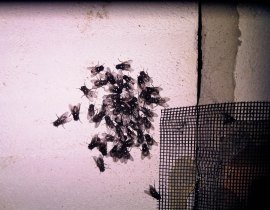Professional Pest Control & Wildlife Management
Cluster Flies
Cluster flies find their way into our homes in autumn and again usually seen again in spring. They seem to come from no-where and sometimes in huge numbers - they can literally cover window sills. Although they carry no real health risks these flies can cause an annoyance from early autumn right through to late spring.
We have a variety of treatments to eliminate cluster fly infestations. As these are a seasonal pest selecting the correct treatment at the right time is essential for effective control of cluster flies.
If you would like to make an appointment, need advice or would like to ask us a question please use the enquiry form or call us on 01284 799398.
-
Risks
Cluster flies do not carry any health risks, they are simply an annoyance.
Prior to any treatment a survey must be conducted to establish whether the loft/cavity space is also being used by bats. It is illegal to do anything which may harm or disturb a bat roost, something a cluster fly treatment would definitely do. If bats are present options are reduced.
-
Treatment
There a number of ways to treat cluster flies. Our preference is based upon results so we choose ULV - Ultra Low Volume.
ULV is essentially a fog or mist created by a special machine. This machine works by breaking our potent insecticide down into tiny particles which float on the air currents, filling a room or loft void and penetrating all the tiny crevices and cracks were the flies like to hide. ULV provides a fantastic instant kill and wipes out all insects present at the time of treatment and it is safe to re-enter a room within a couple of hours.
Electric Fly Killer units offer an insecticide free solution to fly problems. Care must be taken when selecting a machine as it will be left on for extended periods of time unattended. Suitable EFKs will have a large catch tray (several inches deep as a minimum) or take a bin bag – numbers of flies can be so great standard catch trays can over fill and cause a fire risk. We would strongly advise anyone buying an EFK not to purchase on price.
-
Life Cycle
Cluster flies are actually parasitic insects. Don’t worry, its not humans they parasite – its earth worms. The female flies lay their eggs at the entrance to worm holes and in the leaf litter, once hatched the small maggots wriggle down into the ground looking for worms. When they find a suitable host the maggots eat their way into the worms where they stay until they burst out of the then still alive worm. Like other fly species Cluster Flies go from an egg, to a maggot, to a pupae before hatching out into adult fly form.
The reason Cluster flies appear in our homes is because they need to hibernate. In late autumn they enter roof cavities and lofts where they can gather in such large numbers (hence the name ‘cluster’ fly) that they can resemble bunches of grapes stuck on the beams. When the first warm days of spring register and the flies wake from their hibernation they often and mistakenly come down into the house rather than escaping under a roof tile.
Related
- False Widow Spider Removal
- Cluster Fly help
- The trouble with fleas?
- Mole Catching in Suffolk
- Rats in the Garden
- Wasp Nest Control
- Rats in your chicken Coop
- Anaphylaxis
- Bee Swarms
- Becoming a Beekeeper
- Rare Breed Poultry
- Pest Control with Birds of Prey
- Un-marked vehicles available
- Rabbiting with Ferrets
- Myxomatosis
- Poll-Tex Mesh
- Honorary Member Russell Wallis
- Free Rabbit Control


